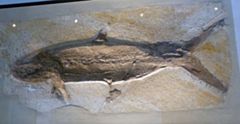Project 4693: Z. Yuan, G. Xu, X. Dai, F. Wang, X. Liu, E. Jia, L. Miao, H. Song. 2022. A new perleidid neopterygian fish from the Early Triassic (Dienerian, Induan) of South China, with a reassessment of the relationships of Perleidiformes. PeerJ. 10:e13448.
Abstract
Neopterygii is the largest clade of ray-finned fishes, including Teleostei, Holostei, and their closely related fossil taxa. This clade was first documented in the Early Carboniferous and underwent rapid evolutionary radiation during the Early to Middle Triassic. This article describes a new perleidid neopterygian species, Teffichthys elegans sp. nov., based on 13 well-preserved specimens from the lower Daye Formation (Dienerian, Induan) in Guizhou, China. The new species documents one of the oldest perleidids, providing insights into the early diversification of this family. The results of a phylogenetic analysis recover Teffichthys elegans sp. nov. as the sister taxon to Teffichthys madagascariensis within the Perleididae. T. elegans sp. nov. shares three derived features of Perleididae: the length of the anteroventral margin of the dermohyal nearly half the length of the anterodorsal margin of the preopercle; the anteroventral margin of the preopercle nearly equal to the anterior margin of the subopercle in length; and the anteroventral margin of the preopercle one to two times as long as the anterodorsal margin of the preopercle. It possesses diagnostic features of Teffichthys but differs from T. madagascariensis by the following features: presence of three supraorbitals; six pairs of branchiostegal rays; relatively deep anterodorsal process of subopercle; absence of spine on the posterior margin of the jugal; and pterygial formula of D26/P14, A22, C36/T39-41. The Perleidiformes are restricted to include only the Perleididae, and other previously alleged ‘perleidiform’ families (e.g., Hydropessidae and Gabanellidae) are excluded to maintain the monophyly of the order. Similar to many other perleidids, T. elegans sp. nov. was likely a durophagous predator with dentition combining grasping and crushing morphologies. The new finding also may indicate a relatively complex trophic structure of the Early Triassic marine ecosystem in South China.Read the article »
Article DOI: 10.7717/peerj.13448
Project DOI: 10.7934/P4693, http://dx.doi.org/10.7934/P4693
| This project contains |
|---|
Download Project SDD File |
Currently Viewing:
MorphoBank Project 4693
MorphoBank Project 4693
- Creation Date:
25 May 2023 - Publication Date:
25 May 2023
Authors' Institutions ![]()
- Institute of Vertebrate Paleontology and Paleoanthropology (IVPP), CAS
- China University of Geosciences
- CAS Center for Excellence in Life and Paleoenvironment
Members
| member name | taxa |
specimens |
media |
| MorphoBank Curator Project Administrator | 3 | 1 | 1 |
| Haijun Song Full membership | 0 | 0 | 0 |
Project has no matrices defined.
Project downloads 
| type | number of downloads | Individual items downloaded (where applicable) |
| Total downloads from project | 1 | |
| Document downloads | 1 | Matrix (1 download); |

